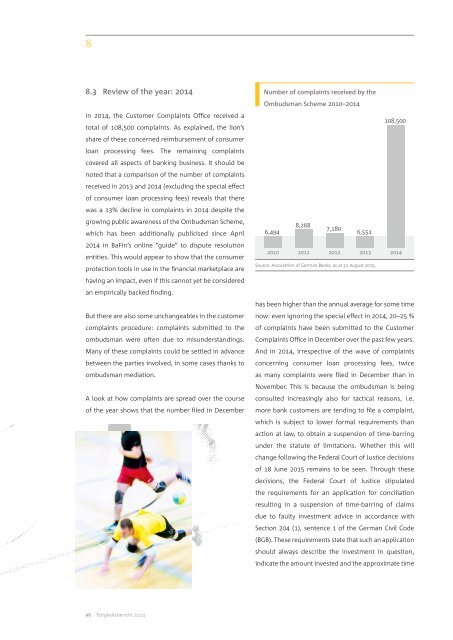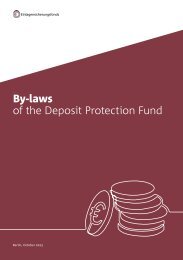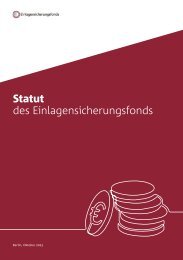Ombudsmann-Tätigkeitsbericht 2014 Englisch
To settle disputes between banks and their customers as quickly and smoothly as possible, Germany's private commercial banks introduced an out-of-court conciliation procedure as early as 1992: the Ombudsman Scheme. The Ombudsman Scheme is the centrepiece of the private commercial banks overall consumer policy scheme, which rests on four pillars: consumer education, consumer information, contract transparency and out-of-court dispute-resolution facilities.
To settle disputes between banks and their customers as quickly and smoothly as possible, Germany's private commercial banks introduced an out-of-court conciliation procedure as early as 1992: the Ombudsman Scheme. The Ombudsman Scheme is the centrepiece of the private commercial banks overall consumer policy scheme, which rests on four pillars: consumer education, consumer information, contract transparency and out-of-court dispute-resolution facilities.
You also want an ePaper? Increase the reach of your titles
YUMPU automatically turns print PDFs into web optimized ePapers that Google loves.
8<br />
8.3 Review of the year: <strong>2014</strong><br />
In <strong>2014</strong>, the Customer Complaints Office received a<br />
total of 108,500 complaints. As explained, the lion’s<br />
share of these concerned reimbursement of consumer<br />
loan processing fees. The remaining complaints<br />
covered all aspects of banking business. It should be<br />
noted that a comparison of the number of complaints<br />
received in 2013 and <strong>2014</strong> (excluding the special effect<br />
of consumer loan processing fees) reveals that there<br />
was a 13% decline in complaints in <strong>2014</strong> despite the<br />
growing public awareness of the Ombudsman Scheme,<br />
which has been additionally publicised since April<br />
<strong>2014</strong> in BaFin’s online “guide” to dispute resolution<br />
entities. This would appear to show that the consumer<br />
protection tools in use in the financial marketplace are<br />
having an impact, even if this cannot yet be considered<br />
an empirically backed finding.<br />
But there are also some unchangeables in the customer<br />
complaints procedure: complaints submitted to the<br />
ombudsman were often due to misunderstandings.<br />
Many of these complaints could be settled in advance<br />
between the parties involved, in some cases thanks to<br />
ombudsman mediation.<br />
A look at how complaints are spread over the course<br />
of the year shows that the number filed in December<br />
Number of complaints received by the<br />
Ombudsman Scheme 2010–<strong>2014</strong><br />
108,500<br />
8,268<br />
7,180<br />
6,494<br />
6,551<br />
2010 2011 2012 2013 <strong>2014</strong><br />
Source: Association of German Banks; as at 31 August 2015.<br />
has been higher than the annual average for some time<br />
now: even ignoring the special effect in <strong>2014</strong>, 20–25 %<br />
of complaints have been submitted to the Customer<br />
Complaints Office in December over the past few years.<br />
And in <strong>2014</strong>, irrespective of the wave of complaints<br />
concerning consumer loan processing fees, twice<br />
as many complaints were filed in December than in<br />
November. This is because the ombudsman is being<br />
consulted increasingly also for tactical reasons, i.e.<br />
more bank customers are tending to file a complaint,<br />
which is subject to lower formal requirements than<br />
action at law, to obtain a suspension of time-barring<br />
under the statute of limitations. Whether this will<br />
change following the Federal Court of Justice decisions<br />
of 18 June 2015 remains to be seen. Through these<br />
decisions, the Federal Court of Justice stipulated<br />
the requirements for an application for conciliation<br />
resulting in a suspension of time-barring of claims<br />
due to faulty investment advice in accordance with<br />
Section 204 (1), sentence 1 of the German Civil Code<br />
(BGB). These requirements state that such an application<br />
should always describe the investment in question,<br />
indicate the amount invested and the approximate time<br />
96 <strong>Tätigkeitsbericht</strong> <strong>2014</strong>


















